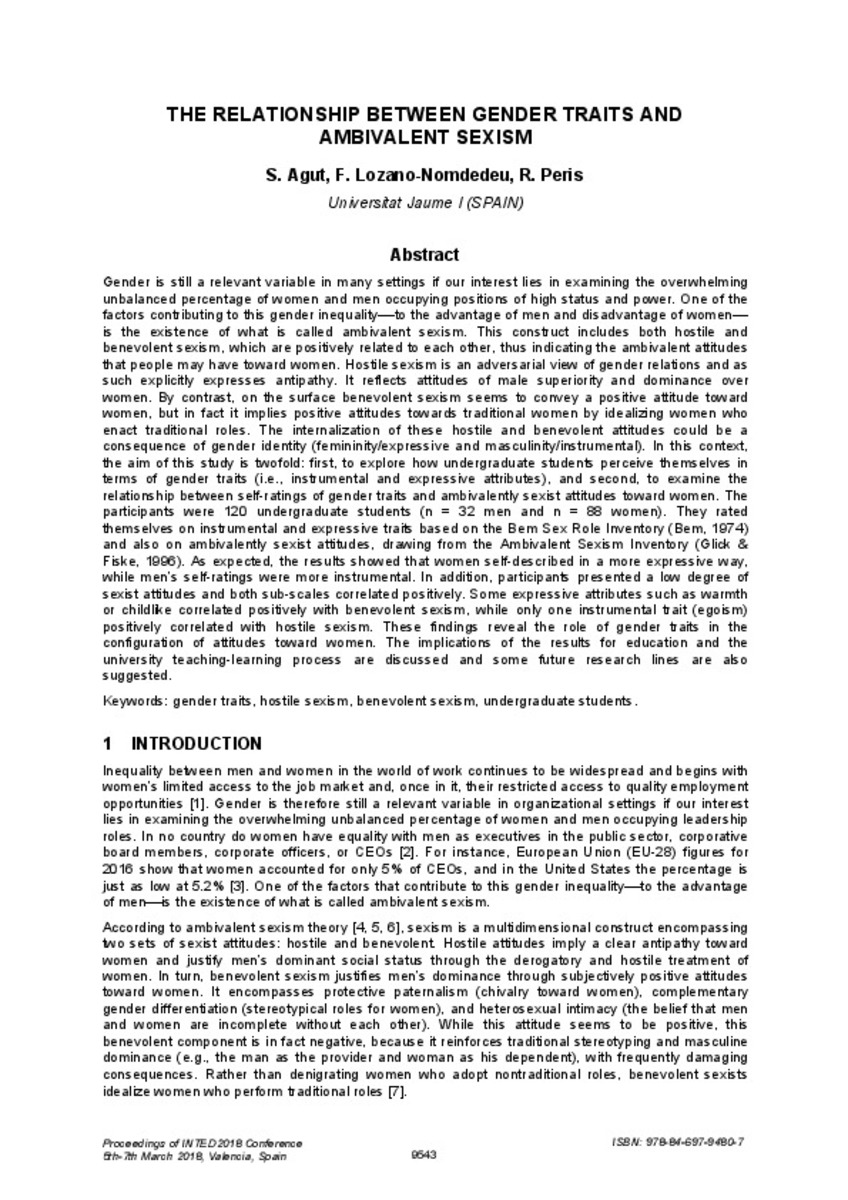Mostrar el registro sencillo del ítem
The Relationship Between Gender Traits and Ambivalent Sexism
| dc.contributor.author | Agut, Sonia | |
| dc.contributor.author | Lozano Nomdedeu, Francisco Alejandro | |
| dc.contributor.author | Peris Pichastor, Rosana | |
| dc.date.accessioned | 2019-02-20T12:42:09Z | |
| dc.date.available | 2019-02-20T12:42:09Z | |
| dc.date.issued | 2018-03-05 | |
| dc.identifier.citation | AGUT NIETO, Sonia; LOZANO NOMDEDEU, Francisco Alejandro; PERIS PICHASTOR, Rosa Ana (2018). The Relationship Between Gender Traits and Ambivalent Sexism. Comunicación presentada en "12th International Technology, Education and Development Conference, 5/3/2018, Valencia (Spain)", p. 9543-9548 | ca_CA |
| dc.identifier.isbn | 9788469794807 | |
| dc.identifier.uri | http://hdl.handle.net/10234/181407 | |
| dc.description | Conference Proceedings of 12th International Technology, Education and Development Conference (INTED 2018) | ca_CA |
| dc.description.abstract | Gender is still a relevant variable in many settings if our interest lies in examining the overwhelming unbalanced percentage of women and men occupying positions of high status and power. One of the factors contributing to this gender inequality––to the advantage of men and disadvantage of women–– is the existence of what is called ambivalent sexism. This construct includes both hostile and benevolent sexism, which are positively related to each other, thus indicating the ambivalent attitudes that people may have toward women. Hostile sexism is an adversarial view of gender relations and as such explicitly expresses antipathy. It reflects attitudes of male superiority and dominance over women. By contrast, on the surface benevolent sexism seems to convey a positive attitude toward women, but in fact it implies positive attitudes towards traditional women by idealizing women who enact traditional roles. The internalization of these hostile and benevolent attitudes could be a consequence of gender identity (femininity/expressive and masculinity/instrumental). In this context, the aim of this study is twofold: first, to explore how undergraduate students perceive themselves in terms of gender traits (i.e., instrumental and expressive attributes), and second, to examine the relationship between self-ratings of gender traits and ambivalently sexist attitudes toward women. The participants were 120 undergraduate students (n = 32 men and n = 88 women). They rated themselves on instrumental and expressive traits based on the Bem Sex Role Inventory (Bem, 1974) and also on ambivalently sexist attitudes, drawing from the Ambivalent Sexism Inventory (Glick & Fiske, 1996). As expected, the results showed that women self-described in a more expressive way, while men’s self-ratings were more instrumental. In addition, participants presented a low degree of sexist attitudes and both sub-scales correlated positively. Some expressive attributes such as warmth or childlike correlated positively with benevolent sexism, while only one instrumental trait (egoism) positively correlated with hostile sexism. These findings reveal the role of gender traits in the configuration of attitudes toward women. The implications of the results for education and the university teaching-learning process are discussed and some future research lines are also suggested. | ca_CA |
| dc.format.extent | 6 p. | ca_CA |
| dc.format.mimetype | application/pdf | ca_CA |
| dc.language.iso | eng | ca_CA |
| dc.publisher | International Academy of Technology, Education and Development (IATED) | ca_CA |
| dc.rights.uri | http://rightsstatements.org/vocab/CNE/1.0/ | * |
| dc.subject | Gender traits | ca_CA |
| dc.subject | Hostile sexism | ca_CA |
| dc.subject | Benevolent sexism | ca_CA |
| dc.subject | Undergraduate students | ca_CA |
| dc.title | The Relationship Between Gender Traits and Ambivalent Sexism | ca_CA |
| dc.type | info:eu-repo/semantics/conferenceObject | ca_CA |
| dc.rights.accessRights | info:eu-repo/semantics/openAccess | ca_CA |
| dc.relation.publisherVersion | http://www.redage.org/eventos/12th-annual-international-technology-education-and-development-conference | ca_CA |
| dc.type.version | info:eu-repo/semantics/publishedVersion | ca_CA |







